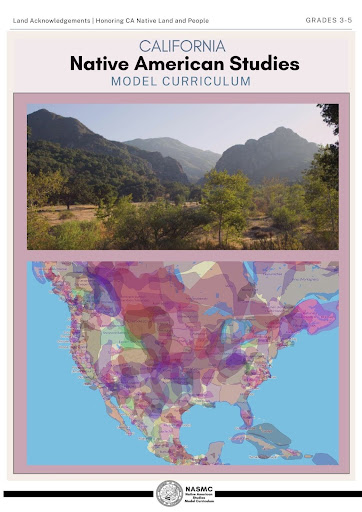Overview
Collaborating with Local Tribal Communities

Authors: The Land Acknowledgments: Honoring CA Native Land and People Unit was researched, authored, and edited by the California Indian Culture and Sovereignty Center, California Indian Museum and Cultural Center, California Indian Education for All, and the San Diego County Office of Education. Key writers and researchers of this unit are Dr. Joely Proudfit, Nicole Lim, Jayden Lim, Taylor Melgoza, and Dr. Staci Block. The unit resources were designed and created from funding through the California Department of Education’s Native American Studies Model Curriculum grant and contract.
Land Acknowledgments: Honoring CA Native Land and People Unit (Lesson 2 of 4)
- Lesson 1 : Understanding Land Acknowledgments
- Lesson 2 : Collaborating with Local Tribal Communities
- Lesson 3 : Moving Beyond Land Acknowledgments
- Lesson 4: Project-Based Learning on Land Acknowledgments
Grades: 3-5
Suggested Amount of Time: 2-3 Weeks (with specific sessions for preparation, collaboration, and reflection)
Curriculum Themes:
- History
- Cultural Strengths
- Relationship to Place
- Cross Curricular Integration
Lesson Highlights
- Students will learn and apply respectful communication protocols when engaging with local California tribal communities.
- Students will incorporate Indigenous voices, perspectives, and feedback into their understanding and representation of local histories and cultures.
Learning Objectives
- Students will gain knowledge about the local Indigenous tribes’ cultural practices, history, and contributions.
- Students will understand the importance of building respectful relationships with tribal communities.
- Students will participate in hands-on activities with local tribal members (e.g., storytelling, art, or land stewardship).
- Students will reflect on their experiences and document their learning through journals or creative projects.
- Students will create and present a final project (e.g., a mural, storybook, or conservation plan) that highlights their learning and collaboration with the tribal community.
Teacher Background
Essential Understandings of California Indian History and Culture
Essential Understanding 1: Great Diversity Among Tribes (EU1 Video) https://bit.ly/NASMC_EU1
Essential Understanding 2: Diversity Among Identity (EU2 Video) https://bit.ly/NASMC_EU2
Essential Understanding 3: Native Traditional Beliefs (EU3 Video) https://bit.ly/NASMC_EU3
Essential Understanding 4: Policies that Affected Tribes (EU4 Video) https://bit.ly/NASMC_EU4
Essential Understanding 6: History from a California Indian Perspective (EU6 Video) https://bit.ly/NASMC_EU6
Unit Background
This unit explores the meaning, purpose, and impact of land acknowledgments, guiding students through a process of critical inquiry, local research, and community engagement. It encourages learners to investigate the histories and ongoing presence of tribal communities in their region, collaborate respectfully with local tribal communities, and reflect on their own roles in acknowledging and addressing historical and contemporary injustices. Through a culminating project, students move beyond symbolic gestures to create meaningful, action-oriented work that honors Indigenous sovereignty and fosters deeper understanding and responsibility. Students will develop a foundational understanding of what land acknowledgments are and why they matter. Through historical research, critical discussions, and case studies, students will explore the origins, purpose, and contemporary use of land acknowledgments, recognizing them as more than symbolic gestures but as opportunities to honor the histories, cultures, and sovereignty of Indigenous peoples. Students will investigate the traditional stewards of the land where their school or community is located, using digital mapping tools, archival sources, and Indigenous-led resources to identify the specific tribal nations connected to their region. Building on this knowledge, the second phase emphasizes relationship-building with local tribal communities. Students will learn about respectful engagement practices, Indigenous protocols, and the importance of listening to and centering Native voices in their work. They will explore ways to collaborate with tribal leaders, cultural educators, and knowledge keepers to ensure their projects reflect authenticity, respect, and reciprocity. These first two lessons lay the groundwork for deeper, more responsible inquiry, preparing students to move beyond acknowledgment and toward meaningful, action-oriented projects that reflect both learning and allyship.
Core Themes:
History and sovereignty
Cultural strengths and Indigenous knowledge systems
Culturally Relevant Terminology
Tribal Nations and Political Identity
Students Will:
Examine the historical and cultural context of land acknowledgments, exploring their purpose, evolution, and use in schools, government, and public institutions.
Research and identify the Indigenous peoples whose ancestral lands they currently inhabit, developing an awareness of local histories and the importance of place-based recognition.
Learn how to engage respectfully with Native communities by studying communication protocols, cultural values, and tribal sovereignty
Incorporate Indigenous perspectives into their understanding of local history, recognizing the value of collaboration, relationship-building, and community consultation.
Critically analyze the limitations of land acknowledgments when they are not accompanied by meaningful action or institutional accountability.
Explore ways to support Native communities through advocacy, education, policy change, and other forms of active allyship, moving toward justice and systemic awareness.
Synthesize their learning in a culminating project that reflects thoughtful engagement with Indigenous histories, cultures, and current issues.
Present their projects to an audience, demonstrating research-based understanding, cultural respect, and a commitment to sustaining awareness and allyship beyond the classroom.